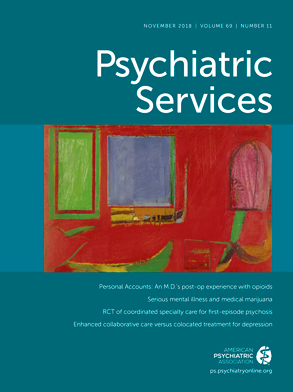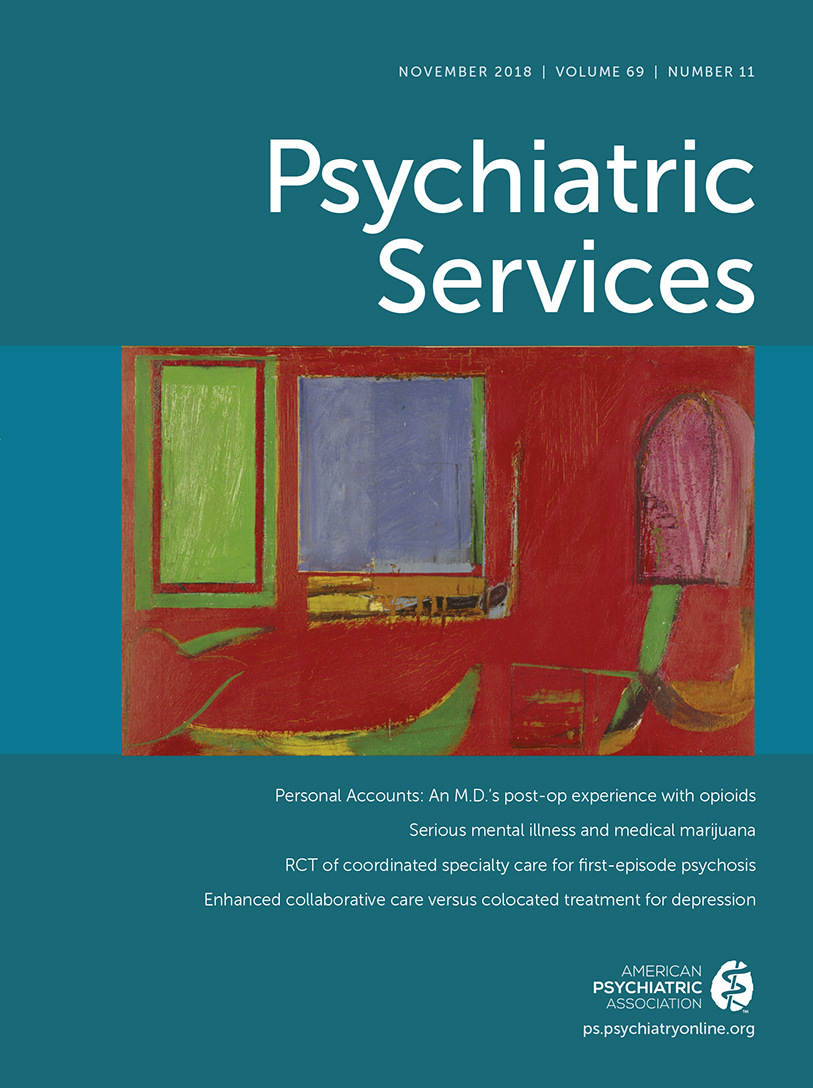Among people with serious mental illness (i.e., schizophrenia, bipolar affective disorder, and recurrent major depression) the prevalence of hepatitis C virus (HCV) is nearly 10 times that of the general population (
1,
2). Although clear guidelines and health mandates to prevent, detect, and treat HCV exist (
3–
7), these recommendations are not routinely provided to those with serious mental illness and are rarely implemented in the mental health systems of care (
8,
9). This is particularly important, given that people with serious mental illness may rely on the mental health system to provide basic medical services (
6,
7). In the absence of adequate screening, people with serious mental illness who are infected with HCV may lack access to treatment. The HCV care continuum (
10) outlines the steps needed for people infected with HCV to move from initial diagnosis to full viral suppression. The extent to which people are lost at each stage of the continuum may provide one measure of how well HCV is being managed within the system of medical care. Barriers to fully accessing and linking to HCV care have been identified and include sobriety requirements, cost, disease severity requirements, and long waits to see specialists. All these barriers may have a particularly hard impact on vulnerable people, such as those with serious mental illness (
11,
12).
The Screening, Testing, Immunization, Risk-Reduction, Integrated Treatment (STIRR-IT) intervention model is specifically designed to target people with mental illness who have co-occurring substance use disorders and is delivered within the mental health care system. STIRR-IT was developed prior to the introduction of direct-acting antivirals for HCV, which provided an opportunity to work with a large portion of patients from the very beginning of their treatment. That may give us a clearer picture of how STIRR-IT affects the ability of a person infected with HCV who has serious mental illness to complete the steps associated with the HCV care continuum.
This study used a mixed-methods approach to evaluate the HCV care continuum among people with serious mental illness and HCV infection who completed the STIRR-IT intervention. Qualitative interviews provided a richer description of the diagnosis and treatment experience for HCV.
Methods
Data for this study were obtained from the assessments of STIRR-IT, an HIV/HCV screening and risk-reduction intervention, colocated within the mental health care system. All clients gave informed consent before participating. The population of focus for this project was African American adults who receive care in an urban behavioral health clinic in the Mid-Atlantic. Blood was drawn on site during the first visit and processed in the University of Maryland Medical Center laboratory. Participants completed the requisite pretest counseling for HIV and viral hepatitis blood testing. Clinical sessions were performed by a registered nurse who is also a trained member of the STIRR-IT team and focused on personalized risk reduction counseling. Vaccines were offered on site, and patients with additional treatment needs were referred to the university infectious disease clinic. All assessments were conducted as in-person interviews. Participants self-reported basic demographic characteristics. After their baseline assessment, a chart review was conducted to record patients’
DSM-5 diagnosis (
13). For patients with multiple diagnoses, the primary diagnosis was chosen. The AIDS Risk Inventory, a frequently used, well-validated instrument with adequate psychometric properties, was used to accurately assess participants’ AIDS risk behaviors, including both sex practices and substance use. Data were analyzed by using SAS, version 9.1.
A purposive sample of nine participants completed qualitative interviews to gain a broader understanding of treatment experience. Participants were asked to give consent again before qualitative interviews. The interviews were semistructured, with a set list of questions asked of all participants and additional follow-up questions to be asked at the discretion of the researcher. All interviews were audio recorded with the patient’s consent. Four trained research assistants listened to each interview recording and noted major themes in patient responses. Focus was placed on four categories of information: diagnosis of HCV, knowledge of HCV, barriers to treatment, and STIRR-IT–specific feedback and general treatment experience.
Results
The mean±SD age of participants (N=170) was 50.6±11.7 years, and 55% (N=94) of participants were male. The vast majority of individuals (N=168, 99%) self-identified as African American or black. All participants were actively receiving mental health treatment at an outpatient mental health clinic and therefore all had DSM diagnoses recorded in their medical records. The most common diagnosis among participants was schizophrenia (N=52, 31%). Schizoaffective disorder (29%, N=49) was the second and major depressive disorder (25%, N=42) was the third most common diagnosis among participants; 21% (N=35) of participants reported having a history of intravenous drug use in their lifetime; and 70% (N=118) of participants reported no alcohol use in the past 30 days.
Out of 170 participants considered for this analysis, 31 (18%) patients tested positive for HCV; 10 (32%) of these participants also tested positive for HIV, and 19 (61%) of these patients were first notified of their HCV status because of their participation in STIRR-IT. Of the 31 patients who tested positive for HCV, 24 (77%) were given referrals to treatment. Ten of the 24 patients (42%) were cured of their HCV infection, while eight (33%) remained in active treatment. Ultimately, nearly 60% of the 31 patients who tested positive for HCV received antiretroviral treatment. [A detailed breakdown of patient progress through the HCV care continuum is available as an online supplement to this article.]
Qualitative interviews revealed that the primary emotion surrounding HCV diagnosis was fear. Patients frequently used phrases such as “overwhelming” and “hard to believe” to describe the initial feelings after hearing of their HCV status. One patient expressed feeling “scared to death.” Patients indicated that the majority of this fear was due to seeing HCV diagnosis as a “death sentence.” Many patients assumed their HCV prognosis was fatal—“I thought I only had months to live.” None of the patients interviewed could recall experiencing symptoms previous to diagnosis.
Confusion surrounding the diagnosis led some patients to suspect that their PCP withheld information—they “didn’t want to scare me,” and “they just told me I have it.” Patients expressed widespread desire to increase the public discussion surrounding HCV. Participants would state that HCV was “familiar” to them but they did not know any information about the disease until diagnosis. Two participants specifically recalled seeing commercials about the disease and referenced the increased risk for the Baby Boom generation—knowledge that motivated getting tested. The education provided via the STIRR-IT program was described as “motivating,” and many stated that they had shared the knowledge about HCV and how it spreads with friends and family.
Barriers to treatment that were mentioned included insurance coverage gaps, treatment sobriety requirements, and a lack of knowledge surrounding risks. Patients did not know they needed to get tested regularly because of a lack of understanding surrounding HCV transmission. Several patients discussed that while they received a diagnosis, they did not have a health care provider who guided them through treatment. Coupled with a lack of knowledge about the long-term effects of HCV, many left their HCV untreated for many years after learning of their diagnosis.
Support systems were repeatedly stated to be the most helpful resource for patients getting treatment; the formation of a “treatment team” was specifically mentioned. Patients greatly valued the colocation of services, describing the ease of being able to discuss infectious diseases and other health concerns within a familiar setting. Many patients had an existing level of comfort within the mental health clinic, which helped them feel more comfortable while confronting health issues. The STIRR-IT program team was described by patients as a “backup plan” during HCV treatment; patients appreciated the ability to reach out if they needed help navigating the health care system. The STIRR-IT team helped several patients contact insurance companies and advocate for needed treatment that was not previously covered.
Discussion and Conclusions
The extent to which people are lost at each stage of the HCV continuum (i.e., diagnosis of HCV, linkage to care, retention in care, and receipt of antiretroviral treatment) may provide one measure of how well HCV is being managed within the system of medical care. Our study found that people with serious mental illness who were diagnosed as having HCV and received the colocated prevention and treatment program, STIRR-IT, were able to appropriately navigate the continuum of care for HCV treatment. Out of the 31 patients who tested positive for HCV during their baseline assessment, nearly 60% (N=18) received antiretroviral treatment, compared with approximately 27% of the general population who receive antiretroviral treatment (
10). This finding is important, given that people with serious mental illness are 10 times more likely than the general population to become infected with HCV (
1,
2) and may face unique challenges and barriers to navigating the complex health care system.
Our study’s prevalence estimate for HCV (18%) is consistent with previous studies that report the range of HCV among people with mental illness to be between 8.1% and 30%. Of note, the vast majority (N=19 of 31, 61%) of participants diagnosed as having HCV in our sample was first identified through HCV testing in the STIRR-IT program. Although most people participating in the project reported having high-risk lifestyles and being within an age cohort that is at a particularly high risk for HCV, fewer than 50% reported being tested previously for HCV. This, too, is consistent with previous research (
14) suggesting that less than half of people with serious mental illness report being tested for HCV. Clearly, the mental health care system has a significant role to play in ensuring that critical screening and testing for HCV (
3–
5,
7,
8) occurs.
Although most participants, prior to entering the program, seemed to have a strong grasp on factors associated with HCV transmission, there appeared to be confusion about the health effects of HCV and treatment availability. Participants who engaged in care through the STIRR-IT program reported that, prior to STIRR-IT, they had felt overwhelmed and confused by insurance coverage, specialty doctors’ visits, and treatment options. Qualitative interviews support that lack of knowledge, lack of support, and fear were all important treatment barriers. Sobriety requirements, length of adherence required for a cure, cost, disease severity requirements, and long waits to see specialists were also of concern (
11,
12).
These results are limited by the lack of a control sample and a lack of healthy control individuals with whom to compare patient experiences. Because of this limitation and the small sample size, these results may not generalize. However, this research’s unique design allows for results that provide in-depth insights that fill a gap in the current understanding of HCV treatment. There is little research dedicated to mentally ill individuals’ experiences navigating the health care system, and the results from this study provide a step toward understanding how to help mentally ill individuals better manage their health care needs.

